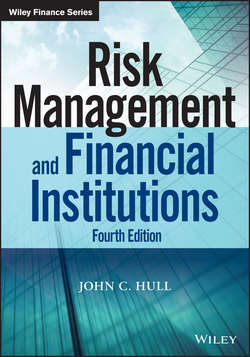Читать книгу Risk Management and Financial Institutions - Hull John C. - Страница 8
На сайте Литреса книга снята с продажи.
CHAPTER 1
Introduction
1.2 THE EFFICIENT FRONTIER
ОглавлениеLet us now bring a third investment into our analysis. The third investment can be combined with any combination of the first two investments to produce new risk-return combinations. This enables us to move further in the northwest direction. We can then add a fourth investment. This can be combined with any combination of the first three investments to produce yet more investment opportunities. As we continue this process, considering every possible portfolio of the available risky investments, we obtain what is known as an efficient frontier. This represents the limit of how far we can move in a northwest direction and is illustrated in Figure 1.3. There is no investment that dominates a point on the efficient frontier in the sense that it has both a higher expected return and a lower standard deviation of return. The area southeast of the efficient frontier represents the set of all investments that are possible. For any point in this area that is not on the efficient frontier, there is a point on the efficient frontier that has a higher expected return and lower standard deviation of return.
FIGURE 1.3 Efficient Frontier Obtainable from Risky Investments
In Figure 1.3 we have considered only risky investments. What does the efficient frontier of all possible investments look like? Specifically, what happens when we include the risk-free investment? Suppose that the risk-free investment yields a return of RF. In Figure 1.4 we have denoted the risk-free investment by point F and drawn a tangent from point F to the efficient frontier of risky investments that was developed in Figure 1.3. M is the point of tangency. As we will now show, the line FJ is our new efficient frontier.
FIGURE 1.4 The Efficient Frontier of All Investments
Point I is achieved by investing a percentage βI of available funds in portfolio M and the rest in a risk-free investment. Point J is achieved by borrowing βJ − 1 of available funds at the risk-free rate and investing everything in portfolio M.
Consider what happens when we form an investment I by putting βI of the funds we have available for investment in the risky portfolio, M, and 1 − βI in the risk-free investment F (0 < βI < 1). From equation (1.1) the expected return from the investment, E(RI), is given by
and from equation (1.2), because the risk-free investment has zero standard deviation, the return RI has standard deviation
where σM is the standard deviation of return for portfolio M. This risk-return combination corresponds to the point labeled I in Figure 1.4. From the perspective of both expected return and standard deviation of return, point I is βI of the way from F to M.
All points on the line FM can be obtained by choosing a suitable combination of the investment represented by point F and the investment represented by point M. The points on this line dominate all the points on the previous efficient frontier because they give a better risk-return combination. The straight line FM is therefore part of the new efficient frontier.
If we make the simplifying assumption that we can borrow at the risk-free rate of RF as well as invest at that rate, we can create investments that are on the continuation of FM beyond M. Suppose, for example, that we want to create the investment represented by the point J in Figure 1.4 where the distance of J from F is βJ times the distance of M from F (βJ > 1). We borrow βJ − 1 of the amount that we have available for investment at rate RF and then invest everything (the original funds and the borrowed funds) in the investment represented by point M. After allowing for the interest paid, the new investment has an expected return, E(RJ) given by
and the standard deviation of the return is
This shows that the risk and expected return combination corresponds to point J. (Note that the formulas for the expected return and standard deviation of return in terms of beta are the same whether beta is greater than or less than 1.)
The argument that we have presented shows that, when the risk-free investment is considered, the efficient frontier must be a straight line. To put this another way there should be linear trade-off between the expected return and the standard deviation of returns, as indicated in Figure 1.4. All investors should choose the same portfolio of risky assets. This is the portfolio represented by M. They should then reflect their appetite for risk by combining this risky investment with borrowing or lending at the risk-free rate.
It is a short step from here to argue that the portfolio of risky investments represented by M must be the portfolio of all risky investments. Suppose a particular investment is not in the portfolio. No investors would hold it and its price would have to go down so that its expected return increased and it became part of portfolio M. In fact, we can go further than this. To ensure a balance between the supply and demand for each investment, the price of each risky investment must adjust so that the amount of that investment in portfolio M is proportional to the amount of that investment available in the economy. The investment represented by point M is therefore usually referred to as the market portfolio.
